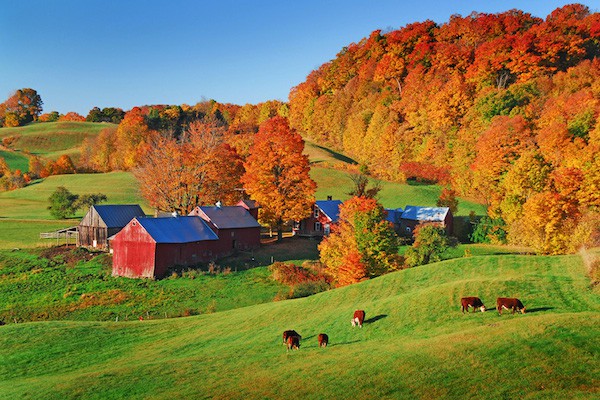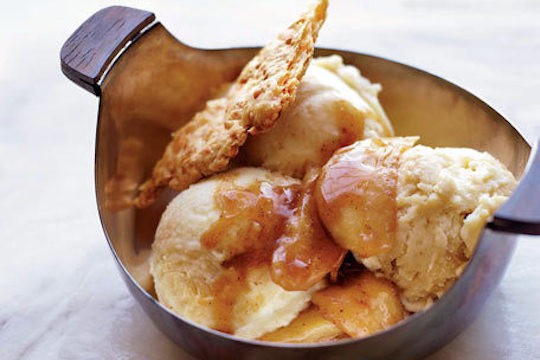
Join intern Virginia on her journey to discover how different regions of the US use local cheeses to improve local cuisine. From Vermont cheddar to Wisconsin Colby and on to California Monterey Jack, she’ll hit the iconic cheese destinations of America and introduce you to regional delicacies and recipes along the way. Did you miss the introduction to this series? No worries; read it here.
Is there anything better than the crisp crunch of an apple accompanied by the smooth sharpness of cheddar cheese? The folks in Vermont don’t think so, and since they’ve been producing some of the country’s best cheddar for the past two hundred years, their opinion carries some weight.

Photo Credit: Kristine LaRue of Love & Zest
History
Cheddar originated in the town of Cheddar in Somerset County, England, in the mid-12th century. In the 12th century, without refrigeration, the bacteria in the cheese ran rampant and gave the cheese an off-putting sharpness until 1857, when Joseph Harding created the process of cheddaring. (Learn more about block cheddar and clothbound cheddar in our Cheese IQ articles.) But, while some English and Midwestern farms managed to grow larger and produce higher volumes of cheddar cheese, the story in Vermont was rather different.

Jenne Farm in Vermont | Photo Credit: George Moy via PBase
In the mid-19th century, the average farm in Vermont had around a dozen cows; each farm would produce its own cheese and butter to feed their family. As time progressed it became apparent that the farmers could only do so much on their small farm and they needed to pool their resources to save time and money. Farmers started bringing excess milk to local co-op factories that would process the milk into cheese and butter more efficiently than could be done on the farm. New techniques and equipment made it possible for the cheese to last longer out of season and used milk that would have otherwise spoiled. During this time Crowley Cheese (est. 1824), the Grafton Cheese Company (est. 1892), and Cabot Creamery (est. 1919) were the most prominent cheese co-ops. The cheese of choice during that time: cheddar, of course! In 1939 the cheese game changed again with the invention of the refrigerated truck, which allowed cheese, milk, butter, and cheese to be shipped all over the Northeast.
The Vermont Cheese Book sponsored by the Vermont Cheese Council explains,
“Making cheese is a basic formula, but Vermont cheese makers are proving that cheese goes beyond a recipe: it takes nurturing both the soil and the flock, tribe or herd with a healthy respect for the process of turning raw milk into cheese. Behind every wedge of soft-ripened, gently seasoned, or wheel of naturally aged Vermont cheese is a passionate cheese maker and a farm, and my book is all about appreciating the story behind Vermont cheese. Vermont cheese makers have made a commitment to a lifestyle and the result is award-winning artisan and farmstead cheese that reflects tradition, dedication and a sense of place”.
Distinguished Vermont Creameries

Photo Credit: Daily Savings All You
Cabot Creamery was founded in 1919 by a group of local farmers who wanted to turn their excess milk into profit and ship it all over New England. Ninety-four farmers jumped onboard; bought a creamery in Cabot, Vermont; and produced butter under the popular brand-name Rosedale.
Over the next 20 years, the farmer-owners became popular in urban areas and grew the creamery so much so that in 1930 there were more cows in the area than people. With so much extra milk, the farmers hired their first cheese maker. By the 1980’s they were able to drop the generic Rosedale name and called themselves Cabot Creamery. Their cheddar cheese earned its first award in 1989, winning first place in the cheddar category at the US Championship Cheese Contest held in Green Bay, Wisconsin.
Today 1,500 farms form the Cabot Creamery, with four processing plants and a large product line. They consistently win award competitions for taste and texture, including the 2014 American Cheese Society Judging & Competition 2nd place award for best 12–14 month aged cheddar. Today, Cabot has a lines of classic cheddar, specially aged cheddar, light cheddar, and flavored cheddar.

Grafton Village Cheese Company was founded in 1892 by farmers who wanted to use their surplus milk and store it for the winter months under the name The Grafton Cooperative Cheese Company. The factory continued for the local farmers until, tragically, in 1912 the factory where the cheese was made burned down. In the mid 1960s the Windham Foundation restored the company.
The Windham Foundation’s purpose is to promote the rural communities of Vermont through philanthropic and educational programs. Each Grafton Village Cheese sold supports communities in rural Vermont and promotes independence among the farmers.
But, in addition to doing good for Vermont communities, Grafton Village cheeses are also highly delicious. They are consistent award-winners in cheese contests. Their products include their 4 Year Aged Cheddar (which won a 2006 World Cheese Award), 3 Year Aged Cheddar, 2 Year Aged Cheddar (which is their most honored cheddar), 1 Year Aged Cheddar, Maple Smoked Cheddar, and Smoked Chili Cheddar.

Shelburne Farms is a nonprofit organization that aims to educate about sustainability. With over 1,400 acres, a working farm, and an entire forest, the farm (a National Historic Landmark) is able to make some truly excellent cheddar. Located on the shores of Lake Champlain in Shelburne, Vermont, the farm’s Brown Swiss cows happily dine on local grasses, which makes for a rich cheddar.
Since 1980 Shelburne Farms has produced artisanal cheddar made from raw milk that is rGBH- and rBST-free, with no artificial flavors, colorings, or preservatives. They are able to produce about 140,000 pounds of cheese a year with only three cheesemakers and three staff members.
Snack Time!
I have lived in the South all my life and just recently moved to the Boston area for school (and cheese!). Before then, I had never experienced the marvelous New England rite of passage: going apple picking. If you’ve never had the opportunity, make plans to try it as soon as you can. There is something special about strolling down a row of apple trees, seeing an apple, and snacking on it right then and there.
Even if you don’t get the chance to go apple picking, this time of year is prime for delicious apples that go amazingly well with the sharp tang of Vermont cheddar cheese. You can simply slice both up and snack on them or you can get a bit fancier. Have you ever added apples to your grilled cheese? No? Well, you should! The sweetness and the crunch of the apple cuts through the cheesy goodness and balances your sandwich out. It’s quite amazing.
Here are a few other wonderful recipes you can try with Vermont Cheddar:
Answer to Win!
This week’s question: How do you like to eat your Vermont cheddar cheese? Post your answer in the comments section by October 15, 2014 for a chance to win a FREE issue of culture magazine! You must be located within the continental US to be eligible to win. Good luck!
Photo Credit: Featured image courtesy of Kristine LaRue of Love & Zest






In chunks.
Also, sandwiches and yes to on apple pie.